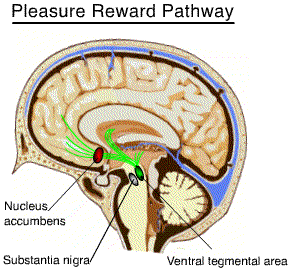Pharmacologic Action
of Meth
 Stimulant drugs such as the amphetamines and methamphetamines alter the release and/or re-uptake of neurotransmitters. They affect the "Pleasure Reward Pathway"(PRP) by altering the level of dopamine present in the synapse. Methamphetamine is chemically similar to dopamine and norepinephrine and readily crosses the blood/brain barrier. It produces its effects by causing dopamine and norepinephrine to be released into the synapse in several areas of the brain. Methamphetamine enters nerve terminals by passing directly through nerve cell membranes. It is also carried into the nerve terminals by transporter molecules that normally carry dopamine or norepinephrine from the synapse back into the nerve terminal. Once in the nerve terminal, meth enters dopamine and norepinephrine containing vesicles and causes the release of these neurotransmitters.
Stimulant drugs such as the amphetamines and methamphetamines alter the release and/or re-uptake of neurotransmitters. They affect the "Pleasure Reward Pathway"(PRP) by altering the level of dopamine present in the synapse. Methamphetamine is chemically similar to dopamine and norepinephrine and readily crosses the blood/brain barrier. It produces its effects by causing dopamine and norepinephrine to be released into the synapse in several areas of the brain. Methamphetamine enters nerve terminals by passing directly through nerve cell membranes. It is also carried into the nerve terminals by transporter molecules that normally carry dopamine or norepinephrine from the synapse back into the nerve terminal. Once in the nerve terminal, meth enters dopamine and norepinephrine containing vesicles and causes the release of these neurotransmitters.
Additionally, meth blocks the breakdown of excess dopamine and norepinephrine. It does so by blunting the effects of Monoamine oxidase (MAO), which is an enzyme capable of cleaving monoamines such as dopamine and norepinephrine. The result is an excess of neurotransmitters.
The high concentration of dopamine within the PRP elicits feelings of pleasure and euphoria. Excess norepinephrine may be responsible for the alertness and anti-fatigue effects of meth.
Interactive Synapse
(Explore the numbered components
in the diagram with your cursor)
©RnCeus.com
 Stimulant drugs such as the amphetamines and methamphetamines alter the release and/or re-uptake of neurotransmitters. They affect the "Pleasure Reward Pathway"(PRP) by altering the level of dopamine present in the synapse. Methamphetamine is chemically similar to dopamine and norepinephrine and readily crosses the blood/brain barrier. It produces its effects by causing dopamine and norepinephrine to be released into the synapse in several areas of the brain. Methamphetamine enters nerve terminals by passing directly through nerve cell membranes. It is also carried into the nerve terminals by transporter molecules that normally carry dopamine or norepinephrine from the synapse back into the nerve terminal. Once in the nerve terminal, meth enters dopamine and norepinephrine containing vesicles and causes the release of these neurotransmitters.
Stimulant drugs such as the amphetamines and methamphetamines alter the release and/or re-uptake of neurotransmitters. They affect the "Pleasure Reward Pathway"(PRP) by altering the level of dopamine present in the synapse. Methamphetamine is chemically similar to dopamine and norepinephrine and readily crosses the blood/brain barrier. It produces its effects by causing dopamine and norepinephrine to be released into the synapse in several areas of the brain. Methamphetamine enters nerve terminals by passing directly through nerve cell membranes. It is also carried into the nerve terminals by transporter molecules that normally carry dopamine or norepinephrine from the synapse back into the nerve terminal. Once in the nerve terminal, meth enters dopamine and norepinephrine containing vesicles and causes the release of these neurotransmitters.